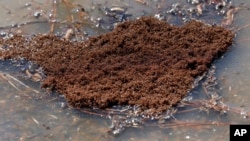A federal parliamentary in Australia is examining the threat from invasive fire ants, which can kill people and livestock and potentially pose more of a danger to Australia than rabbits, cane toads, foxes, camels, wild dogs and feral cats combined.
Lawmakers were holding a public meeting in Canberra Monday to discuss the aggressive insects, which are native to South America and are thought to have entered Australia in shipping containers.
They were first found in Brisbane in 2001 but had probably been undetected in the country for years.
They attack as a swarm. Experts have said they are a danger to people, pets, livestock and wildlife. The ants lock their jaws onto their victim’s skin and inject venom through a spike on their abdomen. Their bite causes a burning sensation, which gives the ants their fearsome name.
A parliamentary inquiry by the Rural and Regional Affairs and Transport References Committee in Canberra is investigating their impact on health, agriculture and the environment.
There is disagreement about the impact of efforts to destroy ant colonies.
The Queensland state government said its eradication programs are “world class.”
Critics, though, have insisted that Australia has mismanaged the threat. The Invasive Species Council, a non-government environmental organization, insists that Australian authorities “underestimated fire ants for 20 years and underfunded our response to them.”
Pam Swepson, a former Community Liaison and Policy Officer at the National Fire Ant Eradication Program, told the Australian Broadcasting Corp. that the ants can be extremely aggressive.
“They are one of the world’s worst invasive species," she said. "They can walk, they can fly, they can swim. They have never been eradicated from any country that they have invaded. If a littler toddler falls onto a nest, which just looks like a pile of dirt, the ants will swarm them and sting them repeatedly and if the person happens to be allergic to their sting, they can go into anaphylaxis and die.”
Monday’s federal hearing in Canberra included submissions from Australia’s National Farmers Federation, government scientists and representatives from the Department of Agriculture, Fisheries and Forestry. Two previous hearings have been held in eastern Australia.
Lawmakers are due to report their findings by April 18.
Australia has had a catastrophic experience with some imported flora and fauna.
The National Fire Ant Eradication Program has warned that “fire ants have the potential to surpass the combined damage done each year by our worst pests: feral cats, wild dogs, foxes, camels, rabbits and cane toads."
Invasive fish and weed species have also caused great environmental damage.
Experts have said that fire ants expand their territory at the rate of about 50-80 kilometers per year in China and the U.S.











